Synchronized skating
Synchronized skating is a gender neutral sport where between eight and twenty figure skaters perform together as a team. They move as a flowing unit at high speed over the ice, while completing complicated footwork and elements.[1] This complex sport was originated in 1956 was first called "precision skating," because of the emphasis on maintaining precise formations and timing of the group. Synchronized skating's popularity has grow immensely over the past 40 years and has been quickly embraced by several European countries who have produced teams that dominate international championships year after year. Today there are more than 600 synchro teams in the United States alone.
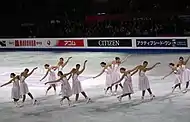
Details
Similar to any other discipline of figure skating, there are many different levels in US Figure Skating at which synchronized skaters can compete. These levels include: Snowplow Sam Synchro, Synchro Skills 1, 2, and 3, Preliminary, Pre-juvenile, Open Juvenile, Juvenile, Intermediate, Novice, Junior, Senior, Open Collegiate, Collegiate, Adult, Open Adult, Open Masters, and Masters.[2] Synchronized skating uses a similar judging system as singles, pairs and ice dancing. The discipline is primarily judged on skating skills, transitions, performance, composition, interpretation and difficulty of elements. What makes the sport so unique is the incredible teamwork, speed, and intricate formations.[3]
Each level performs a free-skate program that requires elements such as circles, lines, blocks, wheels, intersections, no holds, and, at higher levels, lifts. Teams are required to perform step sequences, ranging in difficulty with each level. In the highest ranking levels, Junior and Senior division teams are required to perform the free-skate, also known as long program, as well as a short program. Generally, the short program is more technical in nature, where the free skating program is longer and provides an opportunity to showcase expression, emotion and interpretation.[1]
The different levels are permitted to compete at different competitions. Synchro Skills levels can compete at any U.S. Figure Skating synchronized skating non-qualifying competition or a Learn to Skate USA competition. Preliminary, pre-juvenile, open-juvenile, open-collegiate and open-adult can compete at the same competitions as well the Eastern, Midwestern or Pacific Coast Synchronized Skating Sectional Championships. Teams at the juvenile, intermediate, novice, junior, senior, collegiate, adult or masters are permitted to compete at all competitions listed above. However, at their respective sectional championship a placement in the top four earns them a spot at the U.S. Synchronized Skating Championships. Junior level teams compete in a world qualifying competition where the top two teams attend the Junior World Synchronized Skating Championships. At the senior level, teams compete at nationals for a spot at the World Synchronized Skating Championships, the top two teams attend. [1]
As stated above, a synchronized skating routine may consist of straight line sequences, wheels, blocks, circle step sequences, or also moves in isolation. Moves in isolation, used in more advanced levels, consist of one or more skaters separating from the rest of the team to performs freestyle type moves. For example, three figure-skaters may separate and go into sit spins, while the rest of the team is in a circle formation. The three figure skaters will then join the group again and carry on with the routine. Similarly, Novice, Junior, and Senior programs include moves in the fields. This is where the whole team performs moves such as bellman spirals, 170 spirals, unsupported spirals, spread eagles, or bauers connected.
Required elements[4]
Block
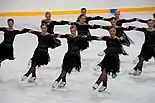
This is an element where the figure skaters are lined up in at least three parallel lines. Five lines is the maximum a block can have. The block should travel over the entire ice surface. The lines should be straight and evenly spaced. To increase the difficulty of the block teams can add step sequences, pivot the block, or change the configuration.
Circle

There are many different ways to complete this element. Teams can have one circle, multiple circles, a circle within a circle, interlocked circles, or a disconnected circle. The circle should be evenly spaced between the skaters and should form a round shape. To increase the difficulty of a circle a team can include step sequences, traveling, and changes of rotational direction. Assisting of travel can also be present in a circle, and is usually noted by a skater trying to cut through the rotation of the circle on a straight path; this will be noticeable with the same jerky/whipping motion of the circle.
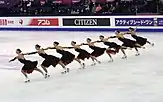
Line
There are many different types of lines. Lines can be two parallel lines, one straight line, or a diagonal line. To increase the difficulty the team may pivot the line, change configuration, or incorporate retrogression into the line.
Wheel
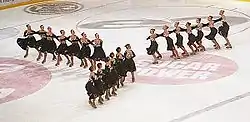
For a wheel every figure skater must rotate around a common center point. There are many different formations that teams can form including a two to five spoke or a parallel wheel. Each spoke (line) of the wheel should be straight and the figure skaters should be leaning into the center of the wheel. The difficulty of the wheel can be increased by adding footwork, changing the rotational direction of the wheel, configuration of the wheel, or traveling. Traveling is difficult because a lot of the time teams will get called for "assisting the travel" which occurs when a team member (usually towards the center) is doing footwork that is not around the center point that is being traveled, but rather they cut through it on a straight path and stop the flow of rotation in an effort to gain more distance up the ice. More often than not, assisting the travel can be spotted because a) a team member will look out of place and b) the wheel will whip or be very jerky in movement.
Intersection

An intersection, also known as a pass through, is when the figure skaters skate towards each other in lines and intersect. The intersection can be two lines, such as an angled intersection, but can have three or four lines, such as a triangle or box. At the point of intersection skaters could do turns or free skating movements to increase the difficulty. The entry to the intersection can be made more difficult by intersecting from an angle or from a whip.
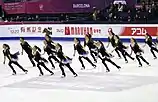
No Hold Element
The no hold element has the same qualities as a regular block. The only difference is that the skaters are not connected in a no hold block. The goal of this maneuver is to stay in perfect alignment while doing the footwork. The neater the block and the harder the footwork, the more points a team can receive.

lift element
This is a free skating move where one figure skater holds on to another. Different types of pairs element include spins, lifts, and pivots such as death spirals. Again, this element is really not a necessity for team skating, but it is seen at the Junior and Senior level. A pairs element can be used to boost skating skills and transition scores.
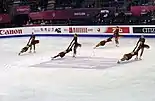
Movement in Isolation
In this element, some of the figure skaters are isolated from the rest of the team while performing free skating elements such as spins, spirals, lifts, vaults, or jumps. The free skating elements must be performed by a minimum of three skaters and a maximum of less than half of the team.

Moves in the Field
This element is a sequence of movements that must include free skating moves such as spirals, spread eagles, Ina Bauers, and other flowing moves with strong edges, connected with linking steps. It must include at least three different free skating moves.
History
The Beginning of Synchronized Skating

In 1956,[5] The first synchronized skating team was formed by Dr. Richard Porter, who became known as the 'father of synchronized skating'. The 'Hockettes' skated out of Ann Arbor, Michigan and entertained spectators during intermissions of the University of Michigan Wolverines hockey team. In the early days, precision skating (as it was then called) resembled a drill team routine, or a precision dance company such as The Rockettes.
During the 1970s, the interest for this new sport spawned tremendous growth and development. As each season passed, more and more teams were developing more creative and innovative routines incorporating stronger basic skating skills, new maneuvers and more sophisticated transitions with greater speed, style and agility. Due to the enormous interest in the sport in North America, the first official international competition was held between Canadian and American teams in Michigan in March 1976. With the internationalization of the sport, it has evolved rapidly, with increasing emphasis on speed and skating skills, and "highlight" elements such as jumps, spirals, spins, and lifts that originally were not permitted in competition.
Competitions
International
There are international synchronized skating competitions at the Senior, Junior, and Novice levels (with Senior being the most elite). The International Skating Union held the first official World Synchronized Skating Championships (WSSC) in 2000 in Minneapolis, Minnesota, USA. The top Junior teams from around the world competed from 2001 to 2012 at the ISU Junior World Challenge Cup (JWCC), held in a different location every year. The JWCC were accompanied in 2013 by the ISU World Junior Synchronized Skating Championships, to be held biannually in odd-numbered years with the JWCC in even-numbered years.[6] Other long-running, major international events attracting elite teams at different levels include the French Cup, Spring Cup, Neuchâtel Trophy, Cup of Berlin, Zagreb Snowflakes Trophy, Leon Lurje Trophy and Prague Cup.
ISU World Synchronized Skating Championships
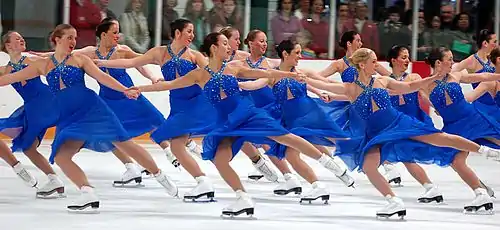
The ISU World Synchronized Skating Championships (WSSC) are the world championships for synchronized skating. Held since 2000, the WSSC is an annual event organized by the International Skating Union and attracts the most elite teams from around the world to compete. The top positions have been dominated by Finland with three different World Champions (Marigold IceUnity, Rockettes and Team Unique) and 19 medals and Sweden with the team (Team Surprise) with most World titles and medals for a single team. Other major countries include Canada with two gold, four silvers and five bronzes (for NEXXICE, Les Suprêmes and the now-discontinued Black Ice), as well as the United States with one silver and four bronzes (for Miami University and Haydenettes, respectively).
ISU World Junior Synchronized Skating Championships
| Year | Location | Gold | Silver | Bronze | Source |
|---|---|---|---|---|---|
| 2020 | [25] | ||||
| 2019 | [26] | ||||
| 2018 | [27] | ||||
| 2017 | [28] | ||||
| 2015 | [29] | ||||
| 2013 | [30] |
ISU Junior World Challenge Cup
| Year | Location | Gold | Silver | Bronze | Source(s) |
|---|---|---|---|---|---|
| 2016 | [31] | ||||
| 2014 | [32] | ||||
| 2012 | [33] | ||||
| 2011 | [34] | ||||
| 2010 | [34][35] | ||||
| 2009 | [34] | ||||
| 2008 | [34] | ||||
| 2007 | [36] | ||||
| 2006 | [34] | ||||
| 2005 | [34] | ||||
| 2004 | [34] | ||||
| 2003 | [34] | ||||
| 2002 | [34] | ||||
| 2001 | [34] |
Finland
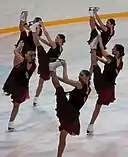
The Finnish member of ISU, the Finnish Figure Skating Association, holds the Finnish Synchronized Skating Championships at the Novice, Junior and Senior levels. Also, it holds two Finnish Championships Qualifiers before the nationals. Since the late 1990s, the senior-level battle for the qualifier wins and Finnish Championship—and the ensuing ISU World Synchronized Skating Championships (WSSC) entries—has mainly been fought between three teams from Helsinki, Marigold IceUnity, Rockettes and Team Unique, while a fourth and sometimes a fifth Senior team has competed along in the intervening years.
Finnish Senior Championships medalists
| Year | Location | Gold | Silver | Bronze | Source |
| 2014 | Helsinki | Marigold IceUnity | Rockettes | Team Unique | [37] |
| 2013 | Turku | Team Unique | Marigold IceUnity | Rockettes | [38] |
| 2012 | Espoo | Rockettes | Marigold IceUnity | Team Unique | [39] |
| 2011 | Espoo | Rockettes | Marigold IceUnity | Team Unique | [40] |
| 2010 | Espoo | Rockettes | Marigold IceUnity | Team Unique | [41] |
| 2009 | Helsinki | Marigold IceUnity | Team Unique | Rockettes | [42] |
| 2008 | Helsinki | Rockettes | Marigold IceUnity | Team Unique | [43] |
| 2007 | Helsinki | Marigold IceUnity | Team Unique | Rockettes | [44] |
| 2006 | Helsinki | Marigold IceUnity | Rockettes | Team Unique | [45] |
Finnish qualifications for the ISU WSSC
Throughout the years, the Finnish senior teams qualifying for the World Championships have been selected based on their performance at the two qualifiers and the national championships. In the season 2012–13, the teams were selected as follows: the Finnish Champion qualified automatically as Team Finland 1 for the WSSC. Team Finland 2 at the WSSC was the team which earned the fewest points from the first qualifier, the second qualifier and the Finnish Championships. The points equaled the sum of the positions at the three competitions with growing coefficients: the coefficient was 0,3 for the first competition result, 0,5 for the second and 1 for the last.[46]
United States
In the United States, there are several other recognized age and skill levels. Sanctioned by the US Figure Skating Association, the divisions include Beginner, Pre-Juvenile, Preliminary, Open Juvenile, Open Collegiate, and Open Adult (the non-qualifying divisions/ the divisions that do not go to Nationals) and Juvenile, Intermediate, Novice, Junior, Senior, Collegiate, Adult, and Masters (qualifying levels).
ISI (Ice Skating Institute) is another governing body which focuses on a more recreational form of competition and does not have the same divisions as those of the USFSA. Teams can compete in the Tot, Jr. Youth, Youth Sr. Youth, Teen, Collegiate, Adult, or Master age groups, in any of five categories: Formation, Advanced Formation, Skating, Open Skating, and Dance.[47]
While most skaters participating in synchronized skating are female, the rules allow mixed-gender teams.
US Figure Skating Senior Championship
The Senior team level consists of 16 skaters. Skaters must be at least 15 years old and have passed the Novice Moves in the Field test.
USFSA Collegiate Championship
The Collegiate team level consists of teams with 12-20 Figure skaters who must be enrolled in a college or degree program as full-time students. Skaters must also have passed the Juvenile Moves in the Field test. It is a Varsity Sport at colleges such as Miami University and Adrian College. Many more have developed club-level collegiate teams without varsity status such as the team at The University of Delaware and the University of Michigan. The Miami University Synchronized Skating Team has been a trailblazer in collegiate synchronized skating, fielding the first completely funded varsity synchronized skating program in the United States, as well as working towards gaining "Synchro" NCAA status in the United States.
| Year | Location | Gold | Score | Silver | Score | Bronze | Score | Source |
|---|---|---|---|---|---|---|---|---|
| 2016 | Kalamazoo, Michigan | Miami University | 90.12 | Univ of Michigan | 86.28 | Metroettes | 82.15 | |
| 2015 | Providence, RI | Miami University | 94.12 | Univ of Michigan | 85.69 | Metroettes | 84.25 | |
| 2014 | Colorado Springs, CO | Miami University | 96.80 | Team Excel | 78.77 | Michigan State | 78.60 | |
| 2013 | Plymouth, MI | Miami University | 92.26 | Univ of Delaware | 84.11 | Univ of Michigan | 77.98 | [52] |
| 2012 | Worcester, MA | Miami University | 87.80 | Univ of Delaware | 84.29 | Univ of Michigan | 80.83 | |
| 2011 | Ontario, CA | Miami University | 96.16 | Michigan State | 85.17 | Univ of Michigan | 83.96 | |
| 2010 | Minneapolis, MN | Miami University | 107.60 | Univ of Michigan | 98.46 | Univ of Delaware | 94.97 | |
| 2009 | Portland, ME | Miami University | 100.63 | Univ of Illinois | 86.79 | Michigan State | 85.79 | |
| 2008 | Providence, RI | Miami University | 107.46 | Univ of Delaware | 97.77 | Michigan State | 87.11 | |
| 2007 | Colorado Springs, CO | Miami University | 102.61 | Michigan State | 92.17 | Univ of Delaware | 88.74 | |
| 2006 | Grand Rapids, MI | Miami University | Western Michigan | Univ of Delaware | ||||
| 2005 | Lowell, MA | Miami University | Western Michigan | Michigan State | ||||
| 2004 | San Diego, CA | Western Michigan | Miami University | Univ of Delaware | ||||
| 2003 | Huntsville, AL | Miami University | Western Michigan | Univ of Michigan | ||||
| 2002 | Lake Placid, NY | Miami University | Michigan State | Western Michigan | ||||
| 2001 | Colorado Springs, CO | Miami University | Western Michigan | Michigan State | ||||
| 2000 | Plymouth, MI | Miami University | Univ of Delaware | Univ of Michigan | ||||
| 1999 | Tampa, FL | Univ of Michigan | Miami University | Univ of Delaware | ||||
| 1998 | San Diego, CA | Miami University | Michigan State | Bowling Green | ||||
| 1997 | Syracuse, NY | Miami University | Bowling Green | Western Michigan |
Present day
Why not Synchro Petition
Although not currently an Olympic sport, it has already been reviewed for Olympic eligibility. Fans and participants of this fast-growing discipline have begun to strive for recognition by the rest of the skating and athletic world. In 2007 synchronized skating took one step closer to Olympic Games contention when it was selected to be part of the Universiade or World University Games as a demonstration sport. Countries from around the world competed in Turin, Italy with Sweden, Finland, and Russia coming out on top.[63]

There are many speculations as to why synchronized skating may never become an Olympic sport. These include:
- Cost and logistics at the Games. Teams of twenty skaters require more money spent on accommodations.
- Mixed gender sport. There are no requirements or regulations surrounding the gender of skaters on a team.
- Not easy to televise. The sport does not convey the same power or speed when it is viewed on TV.
- Lack of interested audience. The sport is relatively low profile in many parts of the world, and may not draw a significant audience.
- Scandal of judged sport. Figure skating already comes under criticism for judging scandals.
- Lack of diversity among contending countries. The sport is dominated by five main countries (Russia, Finland, Sweden, USA, and Canada).
- Lack of countries with teams. At the senior level, there are approximately twenty countries who have teams.
"Why Not Synchro" is an ongoing campaign which became popular over social media through the hashtag #whynotsynchro and #whynotsynchro2018 on Facebook, Twitter, and Instagram. This was popularized at the Mozart Cup, held in Austria in January 2014. During the medal ceremonies, teams gathered on the ice and created the shape of the Olympic rings. This image was then shared widely over social media as skaters petitioned to get awareness about the sport. A petition to the International Olympic Committee was posted on change.org calling for 15,000 signatures and asking the IOC "Synchronized Figure Skating: Make it an Olympic Event." The petition states "The time has come to add this incredible event to the pinnacle of the sport of figure skating." [63]
Effects of COVID-19
Due to the abrupt appearance of COVID-19, the 2019-2020 season was cut short to ensure safety of all teams. Elite US teams like the Haydenettes and Skyliners were not able to compete internationally due to travel restrictions set in place in late March and early April.[64] The US Figure Skating Association ensures that the health and well-being of the athletes, members and figure skating community continues to be their first priority.[65] However, teams and fans from all across the world are hopeful for the opportunity to compete in the upcoming 2020-2021 season.
News Coverage
Synchronized skating has been covered by Skating Magazine since the sport's inception. International and national level competitions are covered by local newspapers highlighting local athletes and teams. Television coverage is taken by major news channels and is usually broadcast after the competition date. US Figure Skating also provides a live streaming service for national synchronized skating competitions.
Judging
International IJS System
The competitive levels of synchronized skating, like those in other disciplines of Figure skating, are now judged using the ISU Judging System that was introduced in 2004. Each element is assigned a difficulty level by the technical panel made-up of a technical specialist, assistant technical specialist and a technical controller. Each level of difficulty for a particular element corresponds to a pre-determined base value. The base value is the number of points that are awarded for an executed element before the grade of execution or any deductions are applied. The base value for every element can be found on the ISU website under ISU Communication 1532, Appendix D. Judges assign a grade of execution from -3 to +3 to each of the elements. Each grade of execution, or GOE, corresponds to a point value. For each element, the highest and lowest GOE values are dropped and the rest are averaged then added to the base value. The sum of all the scores of the elements comprises the Technical Elements score.
Program Component Score
The judges will award points on a scale from 0.25 to 10 (in increments of 0.25) for five program components to grade overall presentation. As with Grade of Execution (GOEs), the highest and lowest scores for each component are thrown out, and the remaining scores are averaged. The final program components scores are then multiplied by a set factor to ensure the technical score and program components score are balanced.[66]
The five program components are:
- Skating Skills - Overall skating quality, including edge control and flow over the ice surface (edges, steps, turns, speed, etc.), clarity of technique and use of effortless power to accelerate and vary speed.
- Transitions - The varied and/or intricate footwork, positions, movement and holds that link all elements.
- Performance - The involvement of the skater physically, emotionally and intellectually in translating the music and choreography.
- Composition - An intentional, developed and/or original arrangement of all types of movements according to the principles of proportion, unity, space, pattern, structure and phrasing.
- Interpretation of Music - The personal and creative translation of the music to the movement on the ice.[66]
Technical Score
Each element of the program is assigned a base value, which gives skaters credit for every element they perform. Some elements, such as spins and step sequences, have levels of difficulty on which the base values are established. Judges grade the quality of each element using a grade of execution score within a range of -5 to +5, which is added to or deducted from the base value. GOEs are proportional to the base value of each element. The highest and lowest scores for each element are thrown out, and the remaining scores are averaged to determine the final GOE for each element. The GOE is then added to or subtracted from the base value for each element, and the sum of the scores for all elements forms the technical score.[66]
Segment Sore
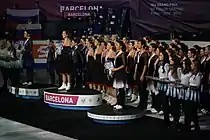
The technical score is added to the program components score to determine the segment score (short program/rhythm dance or free skate/dance). The scores for each segment are then added together to determine the competition score. The skater with the highest competition score is declared the winner. In the event of a tie, the team with the highest free program score wins the competition. The IJS is used at events in the national qualifying structure including the U.S. Championships as well as many local competitions at the juvenile through senior levels, including Excel.[66]
6.0 System
In the United States, the introductory levels of Preliminary, Pre-Juvenile, Open Juvenile, Open Junior, Open Collegiate, Open Adult, and Open Masters are still judged under the 6.0 judging system. These levels can compete at the regional level but cannot qualify for the national championships. The basic principle of the 6.0 system is a “majority” system. Each event is judged by an odd number of judges, and the winner of the event is the team placed highest by a majority of these judges.[66]
Differences in Judging Systems
The IJS is based on cumulative points rather than the 6.0 standard of marks and placement. The IJS focuses on the skaters and not the judges. Judges don’t have to use their memory to compare all aspects of every skater and figure out where to place them, but simply evaluate the qualities of each performance.[66]
Short program
| Rank | Team | Score | Event | Source |
|---|---|---|---|---|
| 1 | 87.84 | 2004 Neuchâtel Trophy | [67] | |
| 2 | 83.46 | 2010 Cup of Berlin | [68] | |
| 3 | 82.36 | 2009 Worlds | [69] | |
| 4 | 80.12 | 2009 Worlds | [69] | |
| 5 | 78.68 | 2009 Worlds | [69] |
Free skating
| Rank | Team | Score | Event | Source |
|---|---|---|---|---|
| 1 | 159.60 | 2004 Neuchâtel Trophy | [70] | |
| 2 | 147.31 | 2014 Worlds | [71] | |
| 3 | 146.03 | 2014 Worlds | [71] | |
| 4 | 145.84 | 2014 Zagreb Snowflakes Trophy | [72] | |
| 5 | 145.68 | 2014 Worlds | [71] |
Combined total
| Rank | Team | Score | Event | Source |
|---|---|---|---|---|
| 1 | 247.44 | 2004 Neuchâtel Trophy | [73] | |
| 2 | 223.90 | 2010 Worlds | [74] | |
| 3 | 223.58 | 2009 Worlds | [75] | |
| 4 | 223.45 | 2014 Worlds | [76] | |
| 5 | 220.54 | 2014 Zagreb Snowflakes Trophy | [77] |
References
- "Synchronized skating". U.S. Figure Skating. Retrieved 2013-03-11.
- https://www.usfsa.org/programs?id=59365
- "TEAM DEFINITIONS - usfsa.org".
- "Synchronized Skating Required Elements" (PDF). U.S. Figure Skating.
- "2013 Synchro Media Guide" (PDF). U.S. Figure Skating.
- "ISU OKs vocal music, awards 2015 championships". Ice Network. 2012-06-18. Retrieved 2013-04-09.
- "ISU World Synchronized Skating Championships 2019 - Synchronized Skating". Isuresults.com.
- "ISU World Synchronized Skating Championships 2018 - Synchronized Skating". Isuresults.com.
- "ISU World Synchronized Skating Championships 2018 - Synchronized Skating". Isuresults.com.
- "ISU World Synchronized Skating Championships 2016 - Synchronized Skating". Isuresults.com. Retrieved 2018-02-22.
- Posted 4/11/15 by Leslie Graham, special to icenetwork. "Canada's Nexxice takes lead in front of home crowd | icenetwork.com: Your home for figure skating and speed skating". Web.icenetwork.com. Retrieved 2018-02-22.
- "Synchronized Skating – Result". International Skating Union. Retrieved 2014-04-05.
- "Synchronized Skating – Result". International Skating Union. Retrieved 2013-04-29.
- "Synchronized Skating – Result". International Skating Union. Retrieved 2013-04-09.
- "Synchronized Skating – Result". International Skating Union. Retrieved 2013-04-09.
- "Synchronized Skating – Result". International Skating Union. Retrieved 2013-04-09.
- "Synchronized Skating – Result". International Skating Union. Retrieved 2013-04-09.
- "Synchronized Skating – Result". International Skating Union. Retrieved 2013-04-09.
- "Synchronized Skating – Result". International Skating Union. Retrieved 2013-04-09.
- "Synchronized Skating – Result". International Skating Union. Retrieved 2013-04-09.
- "Synchronized Skating – Result". International Skating Union. Retrieved 2013-04-09.
- "Synchronized Skating – Result". International Skating Union. Retrieved 2013-04-09.
- "2001 World Synchronized Skating Championships". International Skating Union. Archived from the original on 2016-03-04. Retrieved 2013-04-09.
- "2000 World Synchronized Skating Championships". International Skating Union. Archived from the original on 2016-03-04. Retrieved 2013-04-09.
- "Junior Synchronized Skating". International Skating Union.
- "Junior Synchronized Skating". International Skating Union.
- "Junior Synchronized Skating". International Skating Union. Retrieved 2017-08-11.
- "Junior Synchronized Skating". International Skating Union. Retrieved 2016-07-11.
- "Junior Synchronized Skating". International Skating Union. Retrieved 2014-05-11.
- "Junior Synchronized Skating". International Skating Union. Retrieved 2013-04-11.
- "Synchronized Skating Junior World Challenge Cup 2016" (PDF). International Skating Union. 2016-03-12. Archived from the original (PDF) on 15 September 2016. Retrieved 2016-03-24.
- "Junior World Challenge Cup 2014". International Skating Union. 2014-03-08. Retrieved 2014-03-11.
- "Junior Synchronized". International Skating Union. 2012-03-17. Retrieved 2013-04-11.
- "2012 Synchro Media Guide" (PDF). U.S. Figure Skating.
- "ISU Synchronized Skating". International Skating Union. 2010-03-13. Retrieved 2013-04-11.
- "ISU World Challenge Cup for Juniors". International Skating Union. 2007-03-10. Retrieved 2013-04-11.
- "ML SM 2014 22.-23.2.2014" (in Finnish). Finnish Figure Skating Association. 2014-02-23. Retrieved 2014-03-11.
- "SM-kilpailut 23.-24.2.2013 – SM-seniorit – Result" (in Finnish). Finnish Figure Skating Association. Retrieved 2013-05-10.
- "ML SM-kilpailut 24.-26.2.2012 – SM-seniorit – Result" (in Finnish). Finnish Figure Skating Association. Retrieved 2013-05-10.
- "ML SM-KILPAILUT 4.-6.3.2011 – SM-SENIORIT – Result" (in Finnish). Finnish Figure Skating Association. Retrieved 2013-05-10.
- "Muodostelmaluistelu SM 26.-28.2.2010 – SM-seniorit – Result" (in Finnish). Finnish Figure Skating Association. Retrieved 2013-05-10.
- "SM-kilpailut Seniorit ja Juniorit 6.-7.3.2009 – SM-seniorit – Result" (in Finnish). Finnish Figure Skating Association. Retrieved 2013-05-10.
- "Muodostelmaluistelun SM-kilpailut 22.-24.2.2008 – SM-seniorit – Result" (in Finnish). Finnish Figure Skating Association. Retrieved 2013-05-10.
- "Marigold IceUnitylle Suomen ennätys" (in Finnish). Finnish Figure Skating Association. 2007-03-05. Archived from the original on 2014-12-15. Retrieved 2013-05-10.
- "Marigold IceUnity ja Musketeers Suomen mestari" (in Finnish). Finnish Figure Skating Association. 2006-02-27. Archived from the original on 2014-12-15. Retrieved 2013-05-10.
- "Suomen Taitoluisteluliiton arvokilpailuvalintakriteerit kaudelle 2012-2013" (in Finnish). Finnish Figure Skating Association. Retrieved February 25, 2013.
- "Ice Skating Institute". Skateisi.com. 1990-01-06. Retrieved 2018-02-22.
- "usfigureskating.org". www.usfigureskating.org. Retrieved 2019-03-01.
- "usfigureskating.org". www.usfigureskating.org. Retrieved 2020-03-01.
- "usfigureskating.org". usfigureskating.org. Retrieved 2019-09-14.
- "icenetwork.com". Usfigureskating.org. Retrieved 2018-02-22.
- "icenetwork.com". Usfigureskating.org. Retrieved 2018-02-22.
- "2012 U.S. Synchronized Skating Championships" <http://www.usfsa.org/event_details.asp?id=45734>.
- "2011 U.S. Synchronized Skating Championships" <http://www.usfsa.org/event_details.asp?id=42351>.
- Staed Bishop, Becca (2010-03-06). "Haydenettes blow out competition for senior gold". IceNetwork.
- "2009 U.S. Synchronized Skating Championships." Icenetwork.com. 7 Mar. 2009. Ice Network. 11 Mar. 2009 <http://www.usfigureskating.org/leaderboard/results/50228/results.html>.
- Archived 2014-03-28 at the Wayback Machine
- Archived 2014-03-28 at the Wayback Machine
- Archived 2014-03-28 at the Wayback Machine
- Archived 2014-01-21 at the Wayback Machine
- Archived 2014-03-28 at the Wayback Machine
- "Ann Arbor Hockettes" <http://www.hockettes.com>.
- "The Figure Skating Sport That's So Wild, It Isn't Even in the Olympics Yet". InStyle. Retrieved 2020-07-27.
- https://usfigureskatingfanzone.com/news/2020/3/13/synchronized-skating-season-abruptly-ends-for-us-teams.aspx
- https://www.usfigureskating.org/news/article/considerations-competitions-and-events
- https://www.usfigureskating.org/about/scoring-system
- "Neuchatel Trophy". Swiss Ice Skating. Retrieved 2014-04-17.
- "Cup of Berlin 2010". Deutsche Eislauf-Union. 2010-01-16. Retrieved 2014-04-07.
- "Synchronized Senior - Short Program". International Skating Union. 2009-04-03. Retrieved 2014-04-07.
- "Neuchatel Trophy". Swiss Ice Skating. Retrieved 2014-04-17.
- "Synchronized Skating - Free Skating". International Skating Union. 2014-04-04. Retrieved 2014-04-07.
- "12th Zagreb Snowflakes Trophy 2014". Croatian Skating Federation. 2014-03-01. Archived from the original on 2016-03-03. Retrieved 2014-04-07.
- "Neuchatel Trophy". Swiss Ice Skating. Retrieved 2014-04-17.
- "Synchronized Senior". International Skating Union. 2010-04-10. Retrieved 2014-04-07.
- "Synchronized Senior". International Skating Union. 2009-04-04. Retrieved 2014-04-07.
- "Synchronized Senior". International Skating Union. 2014-04-05. Retrieved 2014-04-07.
- "12th Zagreb Snowflakes Trophy 2014". Croatian Skating Federation. 2014-03-01. Archived from the original on 2015-09-27. Retrieved 2014-04-07.